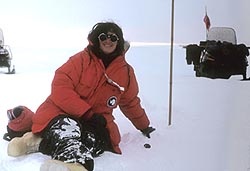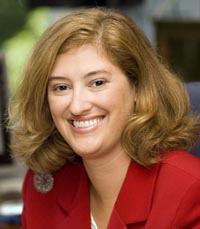Feature
Born to Explore
06.08.06
| Who Are NASA's Space Science Explorers? Who are NASA's Space Science Explorers? The scientist studying black holes in space. The teacher talking about the secrets of the cosmos. And the student asking if there is life away from Earth. All of these people are Space Science Explorers. They are all curious about our solar system and space. This is a story about a NASA Space Science Explorer. Nominate a Space Science Explorer! Tell us about the Space Science Explorers you know. We're looking for students, teachers, scientists and others who have a connection to NASA, whether they work for the agency or are involved in a NASA-supported mission or program. Send your nominations to Dan Stillman: dan_stillman@strategies.org. |
As a kid, she was curious about the world around her. When she got older, her interest spread to the whole universe. She kept exploring as a teacher and then a scientist.

|
| Image above: Laurie Leshin searches for meteorites in Antarctica. Credit: NASA |
The universe is full of things to explore. What is Leshin hoping to find? Why is she looking for water and life in the solar system? How can you become an explorer just like her?
We asked Leshin these and other questions.
Space Science Explorers: How did you first get interested in science?
Leshin: I grew up enjoying the outdoors. I loved rocks and stars. My parents always encouraged me to do whatever I was interested in. I also had some great science teachers. They helped me see that I wanted to study science.
SSE: How did you get to where you are now?
Leshin: One summer in college, I worked at a science research center. There were a lot of scientists there studying the solar system. That got me hooked on space science research. I studied hard and became a college professor. I got to teach great students. I also got to study meteorites. They can tell us a lot about the beginning of the solar system and the planets.
Then, I got the chance to work for NASA. I was really excited about this. NASA needed my help. The president had just come out with a new plan for NASA. Part of my job is to help carry out the plan. I do this by leading the sciences and exploration group at Goddard. This is a huge group of Earth and space scientists. It's amazing how many scientists we have working in one place.
 |
| Image above: Laurie Leshin has explored the world as a student, a teacher and now a scientist. Credit: NASA |
Leshin: We are working on so many projects. These include giant space telescopes and satellites that track hurricanes. I talk to many different people every day. The exciting thing is the wide range of topics. In the morning, I may be talking about a mission to the moon. In the middle of the day, I may be talking about pollution research. Then, in the afternoon, I may be talking about lasers or X-rays.
SSE: What NASA missions have you worked on in the past?
Leshin: I was on the science team for a Mars rover. It was called the Mars Polar Lander. Sadly, it crashed when it reached Mars in 1999. The next few days were really hard. It's hard to lose something that you've put so much work into. But I quickly moved on to another mission, and then another. Once you get that close to exploring another planet, it makes you want to do it even more.
SSE: What future NASA missions are you most excited about?
Leshin: I'm very excited about two missions. One of them is a spacecraft that will make maps of the moon. Astronauts will use these maps when they return to the moon some day. It will also search for water on the moon. The other is a space telescope that will look deeper into the universe than ever before. It will see back to the very first galaxies. This will help us understand how we got here.
SSE: Why are scientists looking for water in the solar system?
Leshin: Life needs liquid water in order to exist. So, finding water on a planet means that life could exist on that planet. I can't imagine a more exciting discovery!
SSE: Besides Earth, what is your favorite planet and why?
Leshin: Mars, definitely. Mars is so much like Earth in some ways. It has volcanoes, ice caps, canyons and dried-up riverbeds. But it is just different enough to make it interesting. Also, it's close enough that we can study it carefully. That means we should be able to find out if there is, or was, life on Mars. I can't wait to find out the answer.
SSE: What advice do you have for kids who might want to become scientists?
Leshin: Go for it! Nothing stands in your way. The exploration you get to do as a scientist is really cool. Every day, you are trying to do things that have never been done before. If you think you want to be a scientist, make sure you learn math and science. Visit science museums, too. Also, try to meet scientists and talk to them about what they do.